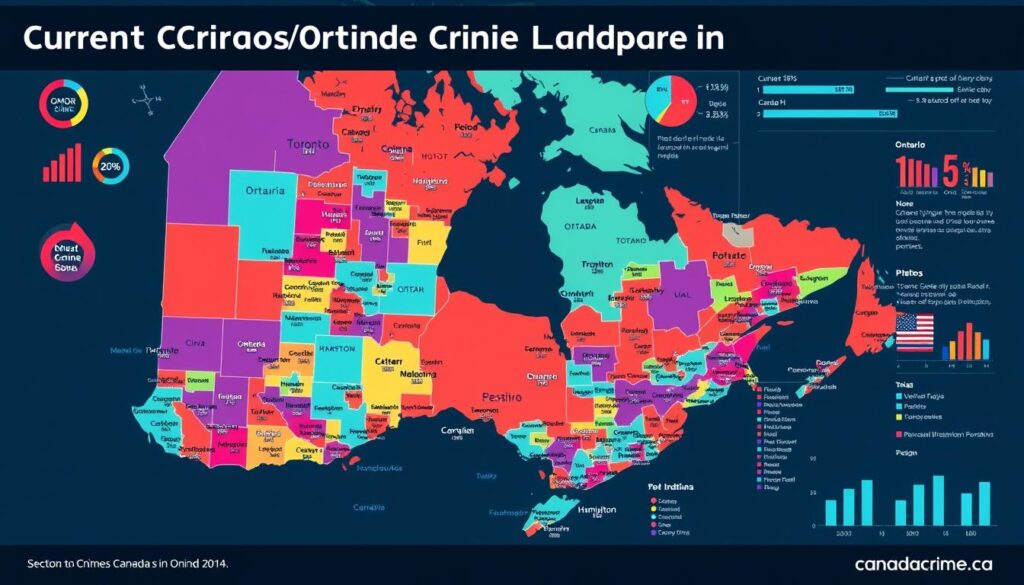According to recent data from Statistics Canada (2024), Toronto stands out as the safest city in Canada, boasting a crime rate of 286.9 offences per 100,000 residents in 2023. This statistic is particularly noteworthy as it encompasses a wide range of criminal activities, including arson, robbery, impaired driving, and burglary.
The Crime Severity Index is a critical metric for understanding the complexity of crime in Ontario. It provides a more nuanced view than simple crime rates by weighting different types of crimes according to their severity.
As we explore Ontario’s crime landscape, we’ll examine how the province compares to national averages and other provinces, and discuss the factors influencing crime rates and the implications for residents and legal professionals alike.
Current Crime Landscape in Ontario
Understanding the crime landscape in Ontario requires a nuanced approach, considering the impact of population density and economic factors. The province’s diverse cities exhibit varying levels of criminal activity, influenced by local policing strategies and socio-economic conditions.

Crime Severity Index in Ontario
The Crime Severity Index (CSI) is a crucial metric for understanding the crime situation in Ontario. It measures the volume and severity of crime, providing a more comprehensive picture than crime rates alone. For instance, Thunder Bay had a CSI of 103.0, representing a 4.4% decrease, while Waterloo Region reported a CSI of 75.5, also down by 4.4%. These figures indicate a general trend of decreasing crime severity in some areas.
Other notable cities in Ontario, such as Ottawa and Hamilton, showed varying trends. Ottawa’s CSI was 55.8, marking a 3.1% increase, whereas Hamilton’s CSI stood at 67.9, up by 5.0%. In contrast, Kingston experienced a slight decrease, with a CSI of 84.1, down by 0.5%. These variations highlight the complexity of crime trends across different urban centers.
Major Crime Indicators in Ontario Cities
Analyzing major crime indicators across Ontario cities reveals significant differences in criminal activity. Cities like Toronto, Ottawa, and Hamilton have distinct crime profiles, influenced by factors such as population density and local policing strategies. For example, the crime rate in Thunder Bay remains a concern, despite the decrease in CSI.
The analysis of year-over-year changes in crime indicators shows that some cities are experiencing decreases in criminal activity, while others see increases. Understanding these trends is crucial for developing effective crime prevention strategies tailored to the specific needs of each city.
Ontario Crime Rate Compared to Other Provinces
Understanding how Ontario’s crime rate stacks up against other Canadian provinces is crucial for a comprehensive view of national crime statistics. This comparison not only highlights regional differences in criminal activity but also provides insights into the factors contributing to these variations.
Ontario vs. Quebec Crime Statistics
Ontario and Quebec, being two of Canada’s most populous provinces, exhibit different crime patterns. According to recent statistics, Ontario has a crime rate of 69.2 per 100,000, while Quebec reports a slightly lower rate. The difference in crime rates between these two provinces can be attributed to various factors, including demographic differences and law enforcement strategies. For instance, Quebec has implemented specific crime prevention programs that have contributed to its lower crime rate. For more information on homicide rates across Canadian provinces, visit Wikipedia’s page on homicide rates.

Ontario vs. Western Provinces Crime Rates
The crime rates in Ontario differ significantly from those in Western Canadian provinces such as British Columbia, Alberta, Saskatchewan, and Manitoba. For example, cities like Edmonton (113.3 per 100,000) and Vancouver (97.0 per 100,000) have higher crime rates compared to Toronto (69.2 per 100,000) and Ottawa (55.8 per 100,000). A closer examination reveals that Western cities often report higher violent crime rates than their Ontario counterparts.
| City | Crime Rate per 100,000 | Change (%) |
|---|---|---|
| Toronto | 69.2 | 11.3% |
| Ottawa | 55.8 | – |
| Vancouver | 97.0 | 5.6% |
| Calgary | 72.5 | -9.6% |
| Edmonton | 113.3 | 0.6% |
The differences in crime rates between Ontario and Western provinces can be attributed to a combination of economic conditions, demographic factors, and geographic considerations. Understanding these factors is crucial for developing effective crime prevention strategies.
Toronto’s Crime Profile: A Closer Look
Understanding crime in Toronto requires analyzing various neighborhoods and their unique challenges. The city’s diverse areas experience different crime rates, making it essential to examine the specific characteristics of each neighborhood.
Top Ten Major Offences in Toronto
Toronto’s crime profile is marked by various major offenses. According to recent data, the top ten major crimes include violent offenses such as assault and robbery, as well as property crimes like auto theft and break-ins. These crimes are not evenly distributed across the city, with some neighborhoods experiencing significantly higher rates than others.
Key statistics indicate that violent crimes are a significant concern in certain areas, while property crimes are more prevalent in others. For instance, neighborhoods with high foot traffic tend to have higher rates of certain types of crime.
Crime Rate by Toronto Neighbourhood
The crime rate varies significantly across Toronto’s neighborhoods. The West Humber Clairville neighbourhood reported the highest number of major crimes, with 1,570 incidents, representing a 30.5% increase over the previous year. Other neighborhoods with high crime rates include Downtown Yonge East, Moss Park, York University Heights, Yonge-Bay Corridor, and Kensington-Chinatown.
Some neighborhoods have seen significant increases in crime rates, such as Princess-Rosethorn (up 215.3%), Kingsway South (up 140.7%), and Miliken (up 110.5%). Socioeconomic factors, population density, and transit access are potential contributing factors to these trends.

The analysis of crime rates across Toronto’s neighborhoods highlights the complexity of the issue. By understanding the specific challenges faced by each area, law enforcement and community initiatives can be more effectively targeted to address the root causes of crime.
Violent Crime Trends Across Ontario
Understanding the dynamics of violent crime in Ontario is crucial for developing effective crime prevention strategies. The province’s crime landscape is influenced by various factors, including socioeconomic conditions and police intervention strategies.
Homicide Statistics in Ontario
Homicide is one of the most severe forms of violent crime. While the overall rate of homicide in Ontario remains relatively low compared to other types of crime, it is essential to monitor the trends and statistics. According to recent data, the homicide rate in Ontario has shown fluctuations, with certain areas experiencing higher rates than others.
| Region | Homicide Rate per100,000 |
|---|---|
| Ontario | 1.2 |
| Toronto | 1.5 |
| Ottawa | 0.8 |
Assault and Robbery Patterns
Violent crimes such as assault and robbery are significant concerns in Ontario. Data from the Toronto Police Service indicates that assault was the most common major offence, with 18,818 incidents reported, representing a 5.7% increase. This included 4,489 assaults with a weapon and 1,001 assaults causing bodily harm. Robbery accounted for 2,312 incidents, also up 5.7%, with 988 involving a weapon.
The rates of assault and robbery vary across different regions in Ontario. Analyzing these patterns can help identify areas that require targeted police intervention and community safety initiatives.

Property Crime Analysis in Ontario
Understanding property crime trends in Ontario is crucial for developing effective prevention strategies. Property crime, which includes offenses such as auto theft and breaking and entering, has significant impacts on individuals, businesses, and communities across the province.
Auto Theft Statistics
Auto theft is a prevalent property crime in Ontario, with various factors contributing to its occurrence. According to recent data, certain regions in Ontario experience higher rates of auto theft, often linked to specific socioeconomic and environmental conditions. Effective prevention strategies, including improved vehicle security measures and community awareness programs, are essential in combating auto theft.
Breaking and Entering Trends
Breaking and entering incidents in Ontario have shown varying trends across different municipalities. In Toronto, for instance, breaking and entering cases have decreased by 3.6% year-to-date, with 5,030 reported incidents, including 1,072 cases of breaking and entering with intent. Cities like Thunder Bay often report higher property crime rates, highlighting the need for targeted prevention initiatives. Analyzing seasonal and temporal patterns in breaking and entering incidents can help identify when and where these crimes most commonly occur, enabling more effective policing and community safety strategies.
| City | Breaking and Entering Incidents | Change from Previous Year |
|---|---|---|
| Toronto | 5,030 | -3.6% |
| Thunder Bay | 1,200 | +2.1% |
| Ottawa | 2,500 | -1.2% |

The analysis of property crime trends in Ontario highlights the importance of tailored prevention strategies. By understanding the specific challenges faced by different regions, law enforcement and community initiatives can be more effectively targeted to reduce property crime rates across the province.
Understanding the Canadian Crime Code
Understanding the Canadian Crime Code is essential for grasping how crimes are prosecuted and sentenced in Ontario. The Code provides a comprehensive framework for criminal law, outlining various offenses and their corresponding penalties.
Key Criminal Code Provisions
The Canadian Crime Code contains several key provisions that are crucial for understanding how crimes are prosecuted. Crimes are categorized based on their severity and the corresponding penalties. For instance, the Code outlines the elements required to constitute a criminal offense, such as actus reus (guilty act) and mens rea (guilty mind).
The Code also provides guidelines for sentencing, ensuring that penalties are proportionate to the offense. This includes considerations for aggravating and mitigating factors that can influence the severity of the sentence.
Legal Classifications of Crimes
Crimes in Canada are legally classified into different categories, including summary, indictable, and hybrid offenses. Violent crimes, such as assault and homicide, are graded based on their severity, with property crime classifications depending on factors like the value of property taken and the method of entry.
| Crime Type | Classification | Penalty Level |
|---|---|---|
| Summary Offense | Less serious | Lower |
| Indictable Offense | More serious | Higher |
| Hybrid Offense | Variable | Variable |

The classification of a crime significantly impacts its prosecution and sentencing. For property crimes, the level of charge and potential penalties are determined by factors such as the value of the property taken and the presence of weapons.
Crime Prevention Strategies in Ontario
Crime prevention in Ontario involves a multi-faceted approach, including community initiatives and law enforcement strategies. Effective crime prevention is crucial in maintaining public safety and reducing crime rates across the province.
Community Safety Initiatives
Community safety initiatives play a vital role in preventing crime. These initiatives often involve collaboration between local organizations, community groups, and law enforcement agencies. For instance, community programs aimed at youth can help deter criminal behavior by providing alternative activities and support. Additionally, initiatives that address underlying social issues, such as mental health concerns, can contribute to a safer community.
- Youth engagement programs
- Mental health support services
- Community policing initiatives
Law Enforcement Approaches
Law enforcement agencies in Ontario are adopting proactive strategies to combat crime. This includes police services implementing targeted patrols in high-crime areas and utilizing intelligence-led policing to address emerging trends. For example, in response to increased violence on public transit, the government deployed additional police officers for 24-hour patrols and community safety ambassadors. Technology is also being leveraged to enhance crime prevention efforts, including surveillance systems and predictive analytics.
According to the Ontario crime prevention framework, collaborative approaches between police and other agencies are crucial. These partnerships help address the root causes of criminal behavior over the years and contribute to a reduction in crime rates at the local level.

Conclusion: The Future of Ontario’s Crime Rate
Looking ahead, the trajectory of Ontario’s crime rate will be shaped by a complex interplay of factors. Historical data from Statistics Canada indicates that while certain crime categories have seen increases, cities like Toronto remain among the safest major urban centers Canada internationally.
Demographic shifts, economic conditions, and technological changes will likely influence future crime rates in Ontario. For instance, population growth in areas like the Waterloo Region and cities such as Thunder Bay may impact local crime trends. Understanding these dynamics is crucial for effective crime prevention.
Ongoing and planned crime prevention initiatives across Ontario, from major cities to smaller communities, are expected to play a significant role in shaping future crime rates. Evolving law enforcement strategies and criminal justice reforms will also be critical in determining the province’s crime landscape over the coming years.
Continued monitoring and analysis of crime statistics, including homicide rates and other violent crimes per 100,000 people, will be essential. This data will inform evidence-based approaches to maintaining and improving public safety across Ontario, ensuring that the province remains a safe environment for its residents.
By examining trends and factors influencing crime rates in Ontario and comparing them with other Canadian cities, stakeholders can develop targeted strategies to address emerging challenges and improve overall safety.

